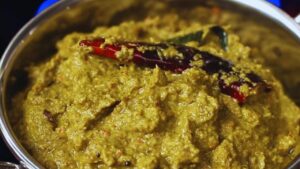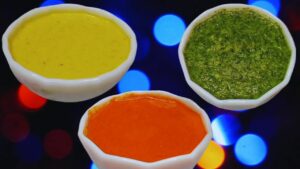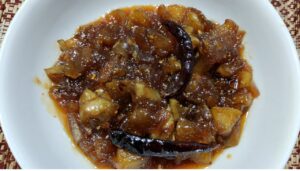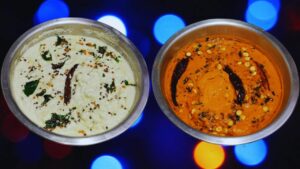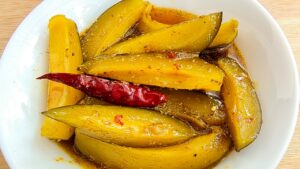Savor the harmonious blend of flavors in my dahi vada chutney recipe. This culinary delight combines dahi vadas with tangy tamarind and refreshing green chutney.
Follow my step-by-step guide for a perfect balance of sweet, spicy, and tangy notes, creating a culinary masterpiece that’s a feast for the senses.

KEY TAKEAWAYS
- Dahi vada chutney offers a delightful blend of tangy tamarind, fresh mint, and aromatic spices, creating a burst of diverse flavors.
- Serve it with classics like dahi vadas, chaats, samosas, and more, or get creative by experimenting with rice dishes for a unique taste.
- Create this culinary masterpiece at home with easy-to-follow steps, adding your own twists for a personalized touch.
- Follow expert tips for roasting spices, achieving the right chutney consistency, and storing it properly to enhance the overall culinary experience.
- Explore other Indian chutneys like date chutney, cilantro chutney, or coconut chutney for a diverse range of flavors that complement various dishes if you run out of it.
How to Cook Dahi Vada Chutney? (Step by Step Guide with Images)
Dahi Vada Tamarind Chutney:
Step 1: Take 200 gms of ripe tamarind with seeds. Break it into small pieces if it comes in a chunk.
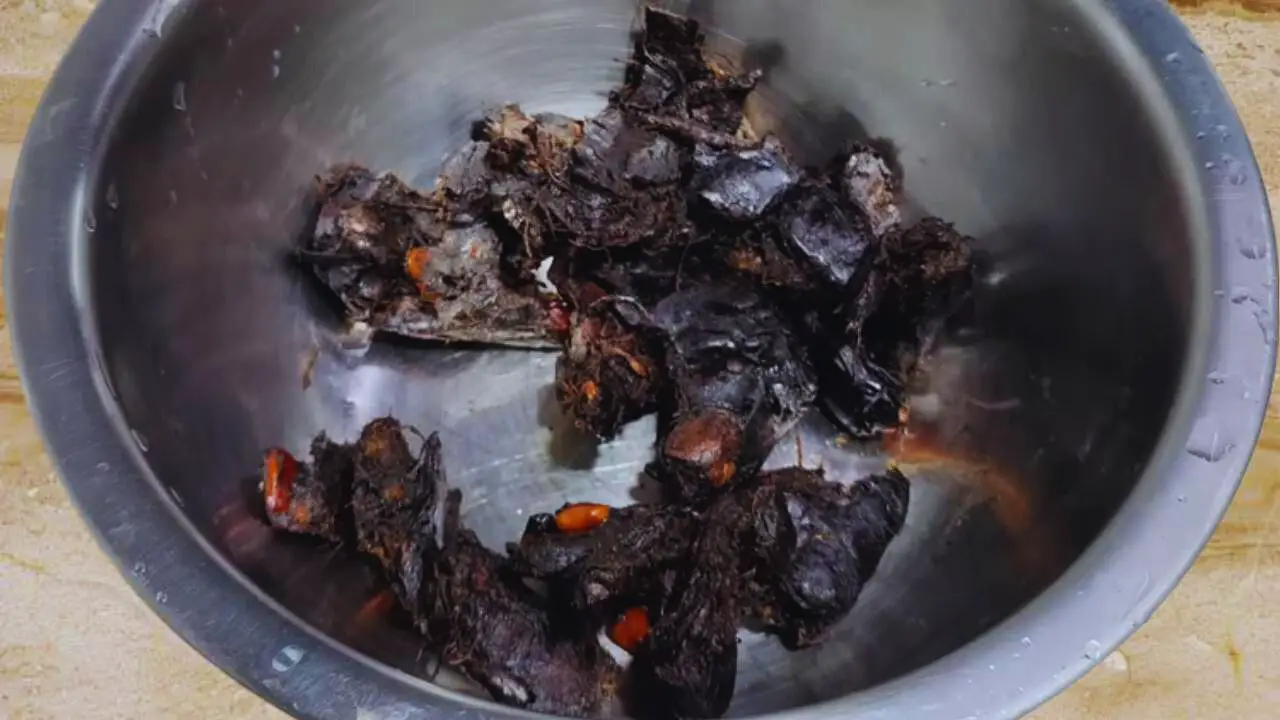
Step 2: Pour about 3 cups of warm water into the bowl, enough to soak all of the tamarind pieces completely.

(Expert tip: You can add normal water but adding warm water will expedite things and make the tamarind softer, which is good for the texture of the tamarind chutney).
Step 3: Let it soak for about 10 minutes so that the tamarind melts nicely and the pulp separates.

Step 4: Mash the pulp with your hands.

Step 5: Take a strainer. Place it in a bowl.
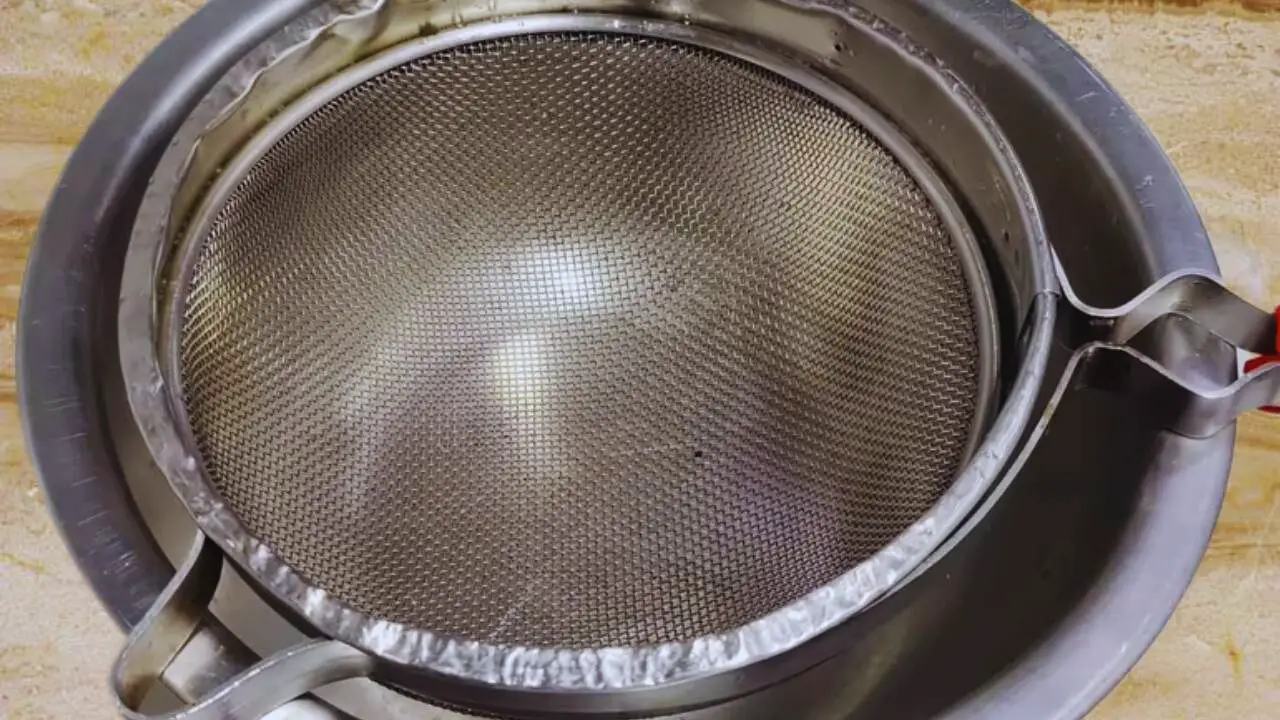
Step 6: Pour the liquified tamarind onto the strainer to separate the pulp and seeds from it.

Step 7: Pour some more warm water and mash the pulp and seeds with your hand. Discard them and put the bowl with liquefied tamarind aside.

Step 8: Now, take a wok and heat it on a high flame on your gas stove.

Step 9: When the wok is hot enough, pour the liquified tamarind in it.

(Expert tip: Do not pour it to the last drop. This will prevent the sand and other impurities from being added to the chutney).
Step 10: Now add 300 gms of jaggery, sliced into small pieces or powdered to the wok.

(Expert tip: If you do not have jaggery at home, do not worry. You can regular sugar to the tamarind. However, adding jaggery will add to the taste and flavor of the tamarind chutney).
Step 11: Stir it nicely for a couple of minutes to mix the jaggery nicely and cook it on a high flame.

Step 12: Now add 1 tsp of Kashmiri red chili powder to the content in the wok.

(Expert tip: Make sure that you keep stirring so that the jaggery does not stick to the wok).
Step 13: Bring it to a boil. When you see the chutney boiling, turn the flame to medium and let the chutney cook for another 15 to 20 minutes.

Step 14: While it cooks, in the meantime, take a frying pan and heat it on a low flame on your gas stove.

Step 15: When the pan is hot enough, add 3 tsp of cumin seeds, 2 tsp of fennel seeds, and 1.5 tsp of black pepper in it.

Step 16: Stir the spices continuously to dry roast them nicely.

Step 17: Turn the flame off when you notice the change in the color and you can smell the aroma of the roasted spices. Let it cool a bit and crush the roasted spices roughly, preferably in a mortar & pestle. Transfer it to a bowl and keep it aside.
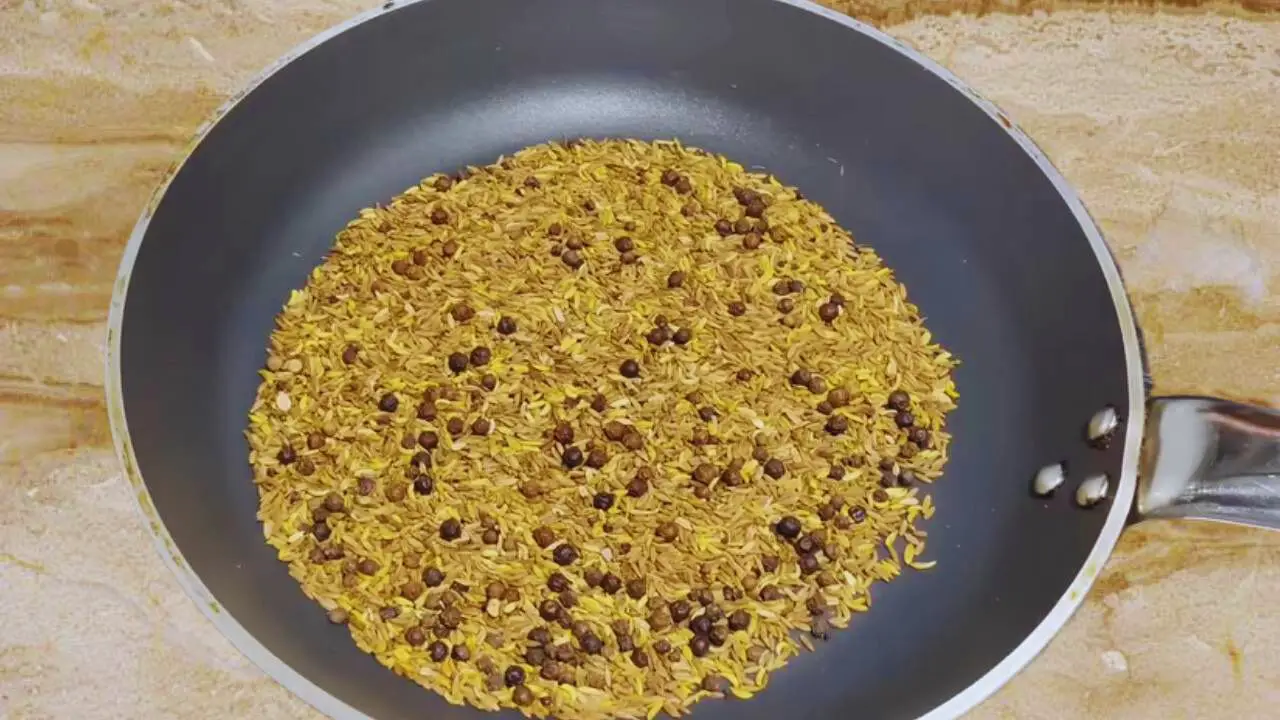
(Expert tip: Do not grind the roasted spices into a fine powder using a mixer-grinder. A coarse powder will give a fine texture and consistency to the tamarind chutney).
Step 18: By this time, the tamarind chutney should have lost enough water to become thick. Check it and boil it for some more time if needed.

Step 19: When you are satisfied with the thickness, add 1.5 tsp of the crushed roasted spices to the chutney.

Step 20: Then add ½ tsp of table salt to the chutney.

Step 21: Follow it with 1 tsp of dry ginger powder.

Step 22: Now add 1 tsp of black salt to the chutney and stir it to mix everything nicely. Cook for some more time so that the chutney becomes thick.

(Expert tip: You can add a little bit of water if you do not want too thick a chutney).
Step 23: Check the consistency and then add ½ tsp of roasted melon seeds to the chutney.

(Expert tip: You may also add cashew nuts to the chutney but make sure that you roast and crush them before adding).
Step 24: Mix it and let it cool. Pour it into a bowl and your tamarind chutney to have with dahi vada is ready.

Dahi Vada Green Chutney:
Step 1: Take a grinder.

Step 2: Put 80 gms of fresh coriander leaves with the stalk in it.

Step 3: Then add 20 gms of fresh mint (pudina) leaves to it.

Step 4: Now put 4 medium pieces of fresh green chilies into it.

Step 5: Follow it with 2 pieces of ice cubes.
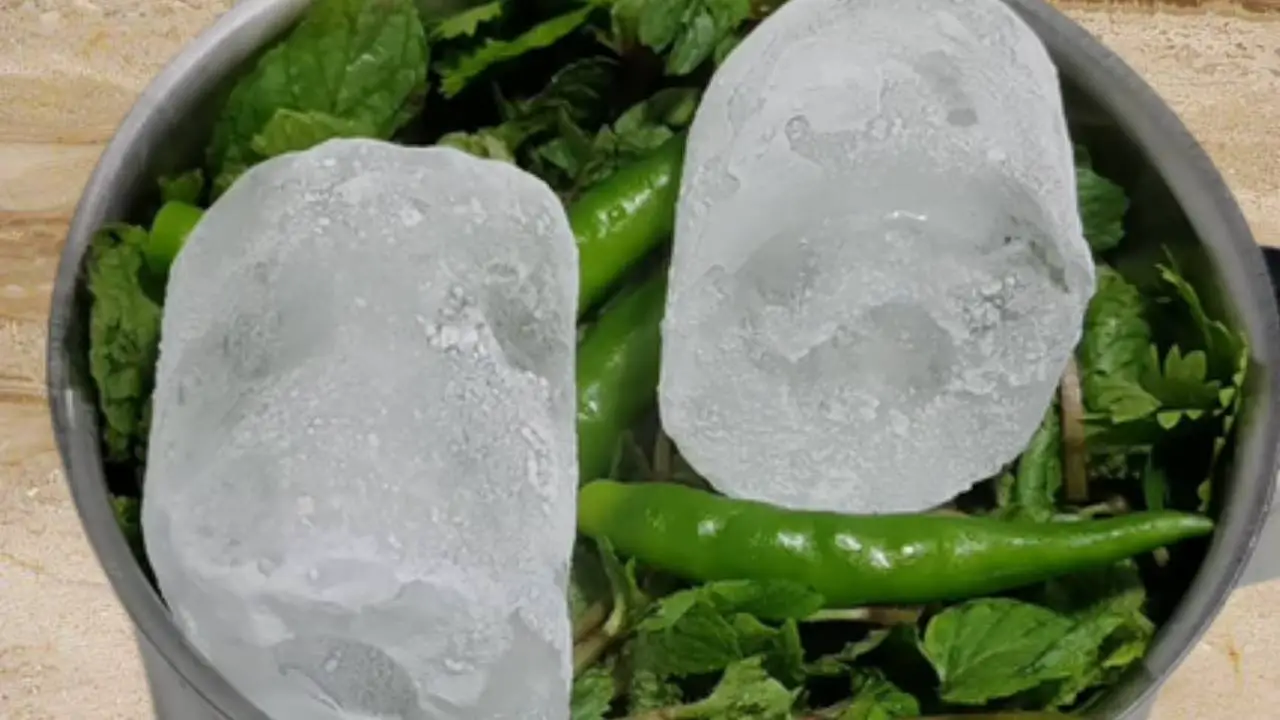
(Expert tip: You can crush the ice cubes into small pieces if you want. Adding ice cubes will enhance the green color of the coriander-pudina chutney and not make it excessively dark).
Step 6: Now, blend the contents nicely into a fine paste.

Step 7: Now, take another bowl with 150 gms of curd (dahi) in it.

Step 8: Whisk it nicely using a whisker.

(Expert tip: Make sure you use thick curd. If you do not, you will not get the desired consistency in your green chutney).
Step 9: Then, add ¼ tsp of regular table salt to it.

Step 10: Follow it with ½ tsp of black salt.

Step 11: Also add ½ tsp of roasted cumin powder to the content in the bowl.

Step 12: Next add ½ tsp of chaat masala powder to it.
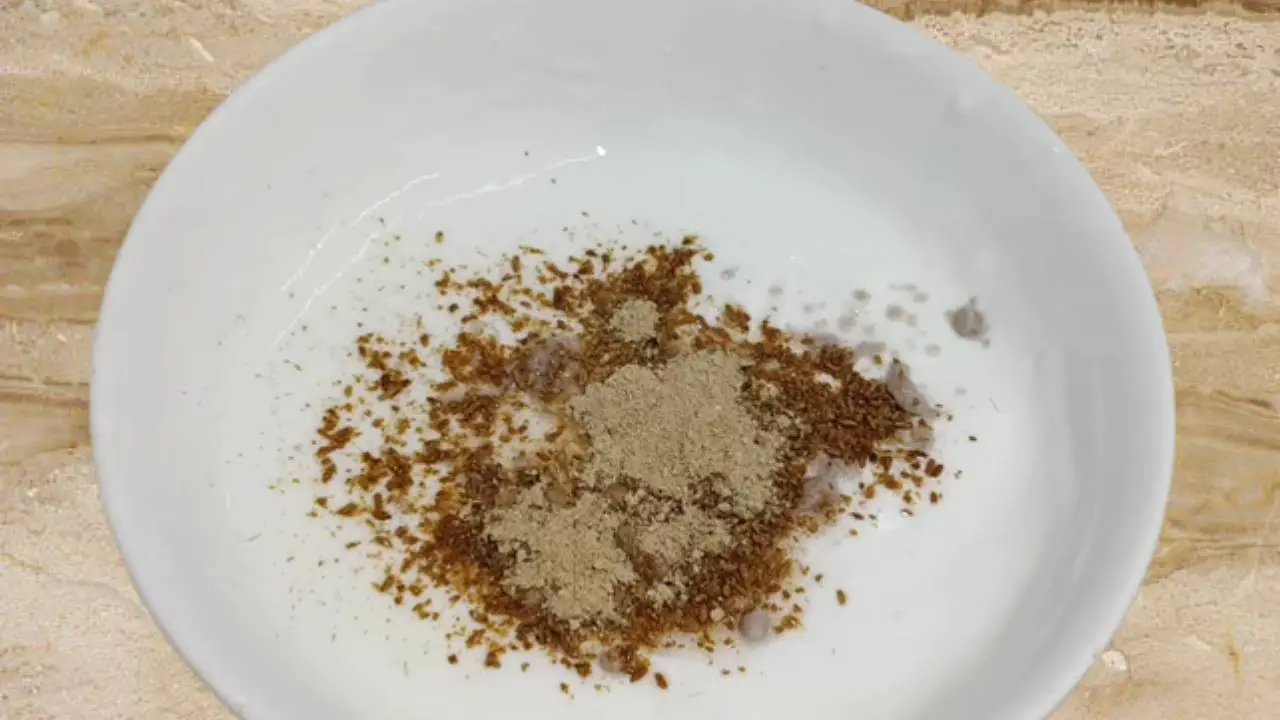
Step 13: Then add a little bit of the coriander-mint paste you made earlier to the content in the bowl.

Step 14: Finally, add ½ tsp of lemon juice to it.

Step 15: Whisk it nicely, add the remaining coriander-pudina paste, and your green coriander-pudina chutney is finally ready to be served with dahi vada.

Pro Tips for Cooking Dahi Vada Chutney
Tamarind Chutney Magic: When preparing tamarind chutney, ensure you don’t pour it to the last drop to avoid adding impurities. Stir consistently while adding jaggery, and don’t hesitate to use regular sugar if jaggery is unavailable for a slightly different but equally delicious flavor.
Spice Roasting Wisdom: Dry roast cumin seeds, fennel seeds, and black pepper for the tamarind chutney. Opt for a coarse crush instead of a fine powder to enhance texture. Keep stirring to prevent sticking, and grind only when you notice a change in color and aroma.
Thickness Check: To achieve the desired thickness in the tamarind chutney, boil it until it loses enough water. If needed, add a bit of water for a thinner consistency.
Creative Touch: Consider adding roasted melon seeds or crushed cashews to the tamarind chutney for an extra layer of flavor and texture.
Green Chutney Brilliance: Use thick curd for the green chutney, ensuring the desired consistency. Crush ice cubes for a vibrant green color without making it excessively dark. Experiment with the amount of coriander-mint paste for your preferred taste.
Serve Chilled: For a refreshing experience, chill both chutneys before serving with dahi vadas.
Experiment and Enjoy: Feel free to explore variations—adjust spice levels, try different nuts, or play with the ratio of chutneys to suit your taste preferences.
Consume Promptly: While homemade chutneys are delicious, they’re best enjoyed fresh. Aim to consume them within a reasonable timeframe to savor their optimal flavors.
Dahi Vada Chutney Storing Tips
Airtight Seal: Keep your homemade dahi vada chutney in an airtight container to preserve its freshness and flavors.
Refrigeration Rule: Store the chutney in the refrigerator to extend its shelf life. Cold temperatures help maintain its taste and texture.
Separate Storage: If you’ve prepared both tamarind and green chutneys, store them separately. This prevents them from blending prematurely, ensuring each retains its distinct flavor.
Use Clean Utensils: When scooping out chutney, always use clean and dry utensils. This helps prevent contamination and maintains the chutney’s quality.
Avoid Direct Sunlight: Store the chutney away from direct sunlight. Exposure to sunlight can alter its taste and consistency over time.
How Does Dahi Vada Chutney Taste?
Tastes of Dahi Vada Tamarind Chutney:
Tangy Explosion: The chutney delivers a delightful burst of tanginess, thanks to the ripe tamarind. This zesty flavor adds a lively kick to every bite.
Sweet Harmony: A perfect balance of jaggery sweetness infuses the chutney, creating a harmonious blend that complements the tangy notes. It’s a sweet symphony for your taste buds.
Spicy Twist: The addition of Kashmiri red chili powder introduces a mild spice that tantalizes your palate without overwhelming, adding a subtle heat to the chutney.
Aromatic Essence: Dry roasting and crushing cumin seeds, fennel seeds, and black pepper infuse the chutney with a rich, aromatic essence, elevating its overall sensory experience.
Savory Undertones: The combination of table salt, black salt, and roasted melon seeds imparts savory undertones, creating a well-rounded flavor profile that keeps you coming back for more.
Ginger Infusion: The subtle warmth of dry ginger powder adds a comforting touch, enhancing the chutney’s complexity with a hint of spiciness.
Tastes of Dahi Vada Green Chutney:
Fresh Herbal Notes: The green chutney introduces fresh, herbal notes from mint, coriander, and green chilies, providing a cool and refreshing contrast to the tamarind base.
Creamy Elegance: The addition of thick curd (dahi) in the green chutney contributes to a creamy elegance, smoothing out the overall taste and complementing the crispiness of dahi vadas.
Citrus Zing: A dash of lemon juice in the green chutney imparts a subtle citrus zing, balancing the richness and enhancing the overall flavor profile.

Dahi Vada Chutney Alternatives
Date Chutney: Swap tamarind for date chutney. Cook dates with water, jaggery, and spices to create a sweet and tangy alternative.
Raw Mango Chutney: Utilize raw mango pulp to achieve a tangy flavor similar to tamarind. Combine with jaggery and spices for a delightful twist.
Sweetened Tamarind Sauce: If pure tamarind is unavailable, you can use pre-made sweetened tamarind sauce. Adjust sweetness and spices according to your preference.
Green Chutney Alternatives:
Cilantro Chutney: A simple cilantro chutney with green chilies, garlic, and lemon juice can be an excellent substitute for the green chutney in dahi vada.
Spinach Chutney: Experiment with a spinach-based chutney for a unique twist. Blending spinach with mint, green chilies, and yogurt creates a vibrant alternative.
Curry Leaf Chutney: Infuse a rich aroma into your green chutney by using curry leaves along with mint and coriander. This alternative adds depth to the overall flavor.
What Dishes Can Dahi Vada Chutney be Served with?
Dahi Vada: The classic pairing! Dahi vada chutney is traditionally served with these lentil-based fried dumplings soaked in yogurt.
Chaat Varieties: Spruce up your favorite chaat recipes such as pani puri, bhel puri, and aloo chaat with dahi vada chutney for an extra layer of flavor.
Samosa: Dip your crispy samosas into dahi vada chutney to enjoy the perfect blend of spicy, tangy, and cooling flavors.
Kachori: Whether it’s Moong Dal Kachori or Aloo Kachori, the chutney adds a delightful kick to these stuffed fried pastries.
Pakoras (Fritters): Serve dahi vada chutney alongside assorted pakoras like onion pakoras, paneer pakoras, or potato pakoras for a tasty snack.
Dhokla: Pair dahi vada chutney with the spongy and steamed Dhokla for a refreshing contrast.
Stuffed Parathas: Enjoy dahi vada chutney with stuffed parathas, enhancing the taste of the bread with its tangy and spicy notes.
Idli and Dosa: Experiment by pairing the chutney with South Indian delicacies like idli and dosa for a fusion of flavors.
Recipe Card

Dahi Vada Chutney
Ingredients
For Dahi Vada Tamarind Chutney:
- 200 grams Tamarind (ripe and with seed)
- 300 grams Jaggery (sliced into small pieces or powdered)
- 1 tsp Kashmiri red chili powder
- 3 tsp Cumin seeds
- 2 tsp Fennel seeds
- 1.5 tsp Black pepper
- ½ tsp Table salt
- 1 tsp Dry ginger powder
- 1 tsp Black salt
- ½ tsp Melon seeds
- 3 cups Warm water
For Dahi Vada Green Chutney:
- 80 grams Fresh coriander leaves (with the stalk)
- 20 grams Fresh mint leaves (pudina)
- 4 pieces Fresh green chilies medium
- 2 pieces Ice cubes
- 150 grams Curd (dahi)
- ¼ tsp Table salt
- ½ tsp Black salt
- ½ tsp Roasted cumin powder
- ½ tsp Chaat masala powder
- ½ tsp Lemon juice
Instructions
For Dahi Vada Tamarind Chutney:
- Soak ripe tamarind pieces in warm water for around 10 minutes until they soften and the pulp separates.
- Strain the liquid tamarind to remove seeds and pulp.
- Cook the tamarind liquid with jaggery (or sugar), spices, and roasted spice mix until it thickens.
- Adjust consistency and add roasted spices, salts, dry ginger powder, and roasted melon seeds. Let it cool, and your Tamarind Chutney is ready.
For Dahi Vada Green Chutney:
- Blend coriander leaves, mint leaves, green chilies, and ice cubes into a paste.
- Whisk thick curd and add regular salt, black salt, roasted cumin powder, chaat masala, lemon juice, and the blended coriander-mint paste.
- Mix well, and your Green Coriander-Mint Chutney is ready to serve with Dahi Vada.
Notes
Nutrition Info (Estimation Only)
Conclusion
In conclusion, dahi vada chutney invites you to savor a symphony of flavors, whether paired with traditional snacks or experimented with in diverse culinary creations.
Embrace the joy of homemade goodness and the art of perfecting this classic Indian accompaniment.

